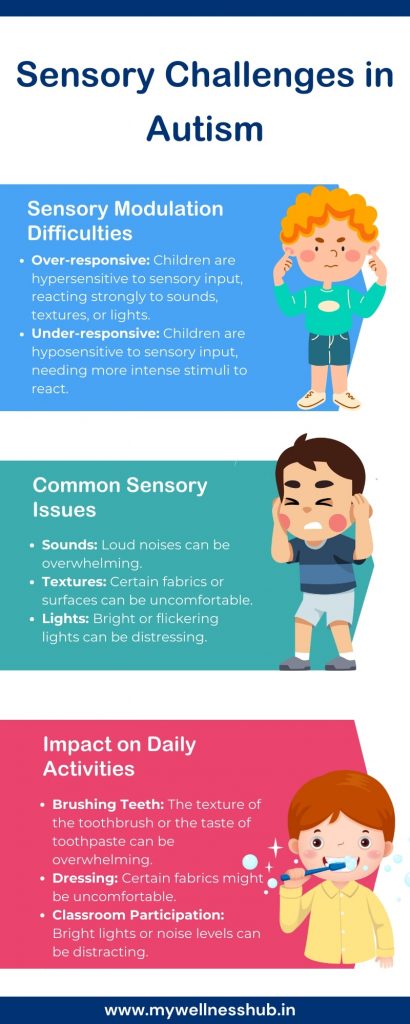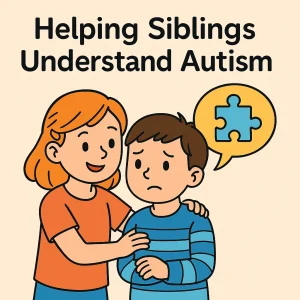Autism and Occupational Therapy: Does It Really Help?
By Wellness Hub
Last Updated: June 29, 2024
Imagine a world where getting dressed in the morning or playing with friends feels overwhelming. This can be the reality for children with Autism Spectrum Disorder (ASD). Occupational therapy (OT) can be a game-changer, helping children with ASD navigate these everyday activities and unlock their full potential. Let’s explore how OT empowers children with ASD to participate more fully in life.
Understanding Occupational Therapy
Occupational Therapy (OT) is a specialized form of therapy that focuses on helping individuals achieve independence in all facets of their lives. The primary goal of occupational therapy is to enable people to participate in the activities of everyday life. For children with autism, this means developing skills that will help them perform essential daily tasks, improve their cognitive and motor functions, and enhance their ability to interact socially and emotionally.
Occupational therapists work with children to build their abilities in various areas, such as self-care, academic performance, and play. By tailoring activities to the individual needs of each child, occupational therapy can significantly enhance a child’s ability to function effectively in their environment.
Read More: Online Occupational Therapy for Kids and Adults
Role of Occupational Therapists in Supporting Individuals with Autism
Occupational therapists play a crucial role in the development and support of children with autism. They conduct thorough assessments to understand each child’s unique strengths and challenges. Based on these assessments, they create customized intervention plans that focus on improving specific skills.
For example, an occupational therapist might work on:
- Motor Skills: Helping children develop both fine motor skills (like writing and buttoning clothes) and gross motor skills (like running and jumping).
- Sensory Processing: Assisting children in managing sensory sensitivities or sensory-seeking behaviors. This can include activities that help a child respond appropriately to different sensory inputs like sounds, textures, and lights.
- Social Interaction: Facilitating better social skills through structured play and interactive activities that teach children how to engage with others.
- Daily Living Skills: Teaching practical skills such as dressing, grooming, and feeding, which are crucial for a child’s independence.
How Occupational Therapy Benefits Children with Autism
Skills Targeted by Occupational Therapy
Occupational therapy aims to enhance various skills in children with autism, addressing their unique needs to help them thrive in daily life. The primary skills targeted include cognitive, physical, social, and motor skills.
- Cognitive Skills: Occupational therapists help children with autism improve their cognitive abilities, such as attention, memory, and problem-solving. These skills are essential for learning and interacting with the world around them.
- Physical Skills: Occupational therapy also focuses on developing physical skills. This includes improving coordination, strength, and balance, which are crucial for performing everyday tasks.
- Social Skills: Social interaction can be challenging for children with autism. Occupational therapists work on enhancing social skills, teaching children how to communicate effectively, understand social cues, and build relationships with peers.
- Motor Skills: Both fine motor skills (e.g., writing, buttoning a shirt) and gross motor skills (e.g., running, jumping) are essential for daily activities. Occupational therapists use various exercises and activities to improve these skills, enabling children to perform tasks more independently.
Sensory Challenges and Occupational Therapy

Explanation of Sensory Modulation Difficulties in Autism
Many children with Autism Spectrum Disorder (ASD) experience sensory modulation difficulties, which can significantly impact their daily lives. Sensory modulation refers to the way the nervous system receives messages from the senses and turns them into appropriate motor and behavioral responses. Children with autism might be hypersensitive (over-responsive) or hyposensitive (under-responsive) to sensory stimuli such as sights, sounds, textures, and smells.
For example, a child with autism might find the sound of a vacuum cleaner unbearable, while another might be indifferent to loud noises but constantly seek out tactile sensations by touching everything. These sensory challenges can make everyday activities, like brushing teeth or participating in classroom activities, overwhelming and difficult to manage.
Use of Sensory-Integration Techniques by Occupational Therapists
Occupational therapists use sensory-integration techniques to help children with autism manage their sensory modulation difficulties. These techniques involve structured activities that are designed to help the child respond more effectively to sensory input. Here are a few common sensory-integration strategies:
- Sensory Diets: This involves a personalized set of activities that provide the sensory input a child needs to stay focused and organized throughout the day. For example, a sensory diet might include activities like swinging, jumping on a trampoline, or using a weighted blanket to help regulate sensory input.
- Desensitization: Gradually exposing a child to sensory stimuli that they find challenging, in a controlled and supportive manner, can help reduce sensitivity over time. For example, if a child is sensitive to loud noises, the therapist might use a series of steps to help the child become more comfortable with these sounds.
- Therapeutic Play: Using play-based activities to help children improve their sensory processing. This could include playing with textured materials, water play, or sandbox activities to help the child become more comfortable with different sensations.
- Environmental Modifications: Adjusting the child’s environment to minimize sensory overload. This might include using noise-cancelling headphones, creating a quiet space for breaks, or using soft lighting to reduce visual stress.
Also read: Parents Guide to Sensory Integration and Occupational Therapy
Effective Strategies Used in Occupational Therapy
Description of Effective Therapies and Strategies
Occupational therapists use a variety of effective strategies and therapies to support children with autism. These methods are designed to address specific challenges and help children develop essential skills. Here are some of the most effective strategies:
- Graphics and Visual Supports: Visual aids such as pictures, charts, and schedules can help children with autism understand and follow routines. These tools provide clear, visual representations of tasks and expectations, reducing confusion and helping children stay organized.
- Sensory Diets: A sensory diet is a personalized plan of physical activities and accommodations designed to provide the sensory input a child needs throughout the day. This can include activities like jumping, swinging, or using a weighted blanket to help regulate sensory processing and improve focus.
- Mindfulness Techniques: Mindfulness activities, such as deep breathing exercises and guided meditation, can help children with autism manage stress and anxiety. These techniques teach children how to calm themselves and stay grounded in the present moment, which can be particularly beneficial during overwhelming situations.
Real-Life Impact of Occupational Therapy
Tips for Parents and Caregivers to Incorporate Therapy Practices into Daily Routines
Integrating occupational therapy practices into daily life can greatly enhance the progress and development of children with autism. Here are some practical tips for parents and caregivers to incorporate these practices seamlessly into everyday routines:
- Create a Structured Routine: Establishing a consistent daily schedule helps children with autism know what to expect, reducing anxiety and improving their ability to transition between activities. Include therapy activities as part of this routine to ensure regular practice.
- Use Visual Supports: Implement visual aids like charts, schedules, and picture cards to help your child understand and follow daily tasks. Visual supports can make it easier for children to grasp concepts and stay organized.
- Incorporate Sensory Activities: Integrate sensory activities that your child enjoys and benefits from into daily routines. This might include using a weighted blanket during quiet time, playing with sensory bins, or doing deep-pressure activities like rolling a therapy ball.
- Practice Self-Care Skills: Encourage your child to participate in self-care tasks such as dressing, brushing teeth, and washing hands. Break these tasks into smaller steps and provide visual or verbal cues to guide them through each step.
- Promote Play-Based Learning: Use playtime as an opportunity to practice motor skills, social interactions, and cognitive tasks. Activities like building with blocks, playing with puzzles, or engaging in pretend play can be both fun and educational.
- Involve Siblings and Peers: Encourage interactions with siblings and peers to help your child practice social skills. Structured playdates and group activities can provide valuable opportunities for learning and growth.
- Stay Positive and Patient: Celebrate small victories and progress, no matter how minor they may seem. Positive reinforcement and patience can boost your child’s confidence and motivation to keep trying.
Importance of Consistency Between Therapy Sessions and Daily Activities
Consistency is key to maximizing the benefits of occupational therapy. Ensuring that therapy practices are consistently applied both during sessions and at home helps reinforce learning and skill development. Here’s why consistency matters:
- Reinforcement of Skills: When therapy techniques are consistently practiced at home, it reinforces what the child learns during therapy sessions. This repetition helps solidify new skills and behaviors.
- Building Routine: Regularly incorporating therapy activities into daily routines helps children with autism develop a sense of structure and predictability, which can reduce anxiety and improve overall functioning.
- Parental Involvement: Active participation by parents and caregivers in therapy practices can lead to better outcomes. By understanding and implementing the techniques used in therapy, parents can provide more effective support and encouragement.
- Continuous Progress: Consistent practice ensures that progress made during therapy sessions is maintained and built upon, rather than lost between sessions. This continuous reinforcement is crucial for long-term development.
Read more: Engaging Home-Based Occupational Therapy Activities for Children with Autism
Conclusion
Occupational therapy empowers children with autism to thrive through improved daily living skills, social interactions, and sensory management. Personalized interventions utilizing tools like sensory diets and visual aids address each child’s unique needs, resulting in a dramatic increase in their independence, function, and overall well-being. If you suspect your child would benefit from OT, don’t hesitate to seek professional guidance.
Frequently Asked Questions:
1. What is occupational therapy for autism?
Occupational therapy (OT) for autism focuses on helping children develop essential skills to improve their daily functioning. This includes enhancing cognitive, physical, social, and motor abilities to support independence and participation in everyday activities.
2. How does occupational therapy benefit children with autism?
Occupational therapy benefits children with autism by addressing sensory challenges, improving motor skills, enhancing social interactions, and teaching daily life skills. These interventions help children manage everyday tasks and interactions more effectively.
3. What are sensory integration techniques in occupational therapy?
Sensory integration techniques are strategies used by occupational therapists to help children with autism manage sensory processing difficulties. These techniques include sensory diets, desensitization, and therapeutic play to improve how children respond to sensory input.
4. What skills do occupational therapists target for children with autism?
Occupational therapists target various skills for children with autism, including cognitive skills (like attention and problem-solving), physical skills (such as coordination and balance), social skills (like communication and interaction), and motor skills (both fine and gross motor skills).
5. How can parents incorporate occupational therapy practices at home?
Parents can incorporate occupational therapy practices at home by creating a structured routine, using visual supports, integrating sensory activities, and practicing self-care skills. Consistent application of these practices helps reinforce what children learn in therapy.
6. Why is consistency important in occupational therapy?
Consistency is crucial in occupational therapy because it helps reinforce the skills learned during therapy sessions. Regular practice at home ensures that progress is maintained and built upon, leading to better long-term outcomes for children with autism.
7. Can occupational therapy improve social skills in children with autism?
Yes, occupational therapy can significantly improve social skills in children with autism. Therapists use play-based activities and structured interactions to teach children how to communicate effectively, understand social cues, and build relationships.
8. What are some effective strategies used in occupational therapy for autism?
Effective strategies in occupational therapy for autism include sensory diets, visual supports, mindfulness techniques, and therapeutic play. These strategies are tailored to meet each child’s specific needs and help them develop essential skills.
9. How do sensory diets help children with autism?
Sensory diets provide structured activities that offer the sensory input children with autism need to stay focused and organized. These activities help regulate sensory processing and improve a child’s ability to participate in daily activities.
10. Where can I find resources on occupational therapy for autism?
For more information and resources on occupational therapy for autism, you can visit Wellness Hub’s occupational therapy resources. Wellness Hub offers a range of support and guidance for families navigating the journey of autism.
About Author
Prapoorna Mangalampalli
M.Sc., M.A., (Dual Masters in Psychology and Senior Content Developer) – Counselor (6+ years of experience)
Prapoorna is a skilled counselor with dual Master’s degrees in Psychology and English. With more than six years of professional experience, she specializes in providing various types of counseling, including online Therapy , Marital , Relationship, child, family, and career counseling. Prapoorna is part of the Wellness Hub team, where she contributes significantly to their mission. She values a team-based approach and is committed to innovation, compassion, and the success of her clients. Her diverse educational background and extensive experience enable her to offer insightful and effective counseling services that positively impact individuals and families.
Book your Free Consultation Today
Parent/Caregiver Info:
Client’s Details:
* Error Message









